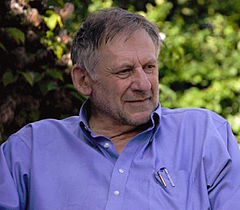Christopher Alexander
Christopher Alexander, Christopher Wolfgang John Alexander (ur. 4 października 1936 w Wiedniu, Austria - zm. 17 marca 2022 w Bisted, Wielka Brytania) – brytyjsko-amerykański architekt i teoretyk projektowania. Znany jest m.in. jako autor książki "Język wzorców" (ang. A Pattern Language) z 1977 roku. Jest uważany za twórcę “The Pattern Language Movement"[1][2][3][4].
 Christopher Alexander w 2012 roku | |
| Imię i nazwisko |
Christopher Wolfgang John Alexander |
|---|---|
| Data i miejsce urodzenia |
4 października 1936 |
| Data i miejsce śmierci |
17 marca 2012 |
| Narodowość | |
| Język |
angielski |
| Alma Mater |
Oundle School, Kolegium Trójcy Świętej w Cambridge, Uniwersytet Harvarda, Massachusetts Institute of Technology |
| Dziedzina sztuki | |

Życiorys
edytujAleksander urodził się w Wiedniu, w Austrii. Jego ojciec, Ferdinand Johann Alfred Alexander, był katolikiem, a jego matka, Lilly Edith Elizabeth Alexander, była Żydówką. Jako małe dziecko Aleksander wyemigrował jesienią 1938 roku wraz z rodzicami z Austrii do Wielkiej Brytanii, kiedy jego rodzice zostali zmuszeni do ucieczki przed nazistowskim reżimem. Większość dzieciństwa spędził w Chichester i Oksfordzie w Anglii, gdzie rozpoczął naukę w Oundle School. Przeniósł się z Anglii do Stanów Zjednoczonych w 1958 roku, aby studiować na Uniwersytecie Harvarda i Massachusetts Institute of Technology.
W 1963 roku Alexander przeniósł się do Kalifornii, do Berkeley gdzie został profesorem na Uniwersytecie Kalifornijskim[5].
W dniu 17 marca 2022 roku Alexander zmarł w swoim domu w Binsted, niedaleko Arundel w Wielkiej Brytanii, po długiej chorobie. Przyczyną było zapalenie płuc, powiedziała jego żona Margaret Moore[1].
Wybrane projekty
edytuj- Kampus Uniwersytetu Eshin, Tokio,1985 rok[6][7]
- The West Dean Visitors Centre w hrabstwie West Sussex, Anglia[8]
- Sala House w Albany, Kalifornia[9]
- Julian Street Inn (schronisko dla bezdomnych), San Jose, Kalifornia[8]
- Medlock House, Whidbey, Waszyngton, 1991 rok[10][11]
Ważniejsze publikacje
edytuj- Community and Privacy, wspólnie z Sergem Chermayeffem (1963)
- Notes on the Synthesis of Form (1964)
- A City is Not a Tree (1965)
- The Atoms of Environmental Structure (1967)
- A Pattern Language which Generates Multi-service Centers, wspólnie z Sarą Ishikawą i Murrayem Silversteinem (1968)
- Houses Generated by Patterns (1969)
- The Grass Roots Housing Process (1973)
- The Center for Environmental Structure Series, składa się z:
- The Oregon Experiment (1975)
- A Pattern Language, wspólnie Sarą Ishikawą i Murrayem Silversteinem (1977)
- The Timeless Way of Building (1979)
- The Linz Cafe (1981)
- The Production of Houses, wspólnie z Howardem Davisem, Julio Martinezem i Donem Cornerem (1985)
- A New Theory of Urban Design, wspólnie z Hajo Neisem, Artemisem Anninou i Ingrid King(1987)
- Foreshadowing of 21st Century Art: The Color and Geometry of Very Early Turkish Carpets (1993)
- The Mary Rose Museum, with Gary Black and Miyoko Tsutsui (1995)
- The Nature of Order Book 1: The Phenomenon of Life (2002)
- The Nature of Order Book 2: The Process of Creating Life (2002)
- The Nature of Order Book 3: A Vision of a Living World (2005)
- The Nature of Order Book 4: The Luminous Ground (2004)
- The Battle for the Life and Beauty of the Earth: A Struggle between Two World-Systems, wspólnie z Hansem Joachimem Neisem i Maggie More Alexander (2012)
Przypisy
edytuj- ↑ a b Penelope Green, Christopher Alexander, Architect Who Humanized Urban Design, Dies at 85, „The New York Times”, 29 marca 2022, ISSN 0362-4331 [dostęp 2023-06-12] (ang.).
- ↑ l, Język wzorców. Miasta - budynki - konstrukcja - Książka | Księgarnia internetowa Poczytaj.pl [online], www.poczytaj.pl [dostęp 2023-06-12] (pol.).
- ↑ Howard Davis, Christopher Alexander obituary, „The Guardian”, 29 marca 2022, ISSN 0261-3077 [dostęp 2023-06-12] (ang.).
- ↑ Patricia Leigh Brown, A Design Controversy Goes Cozy.com., „The New York Times”, 23 listopada 2000, ISSN 0362-4331 [dostęp 2023-06-14] (ang.).
- ↑ Christopher Alexander [online], UC Berkeley College of Environmental Design [dostęp 2023-06-12] (ang.).
- ↑ Eishin School by Christopher Alexander at GreatBuildings [online], GreatBuildings [dostęp 2023-06-13] (ang.).
- ↑ David Seamon, Ingrid Stefanovic, Christopher Alexander’s “Battle for the Life and Beauty of the Earth” (2013), „Published in ENVIRONMENTAL & ARCHITECTURAL PHENOMENOLOGY, vol. 24, winter 2013” [dostęp 2023-06-14].
- ↑ a b Ansha Kohli, Christopher Alexander- 12 Iconic Projects [online], RTF | Rethinking The Future, 3 grudnia 2020 [dostęp 2023-06-14] (ang.).
- ↑ Daphne White, Christopher Alexander-designed house with 'dreamlike' qualities for sale in Albany [online], Berkeleyside, 14 kwietnia 2018 [dostęp 2023-06-14] (ang.).
- ↑ Christopher J. Thornton, Truth from Trash, 2000, DOI: 10.7551/mitpress/6924.001.0001 [dostęp 2023-06-14].
- ↑ Whidbey Island Pattern House [online], digitalcollections.lib.washington.edu [dostęp 2023-06-14] (pol.).
Bibliografia
edytuj- Deyan Sudjic, Język miast, Karakter, Kraków 2017.
Linki zewnętrzne
edytuj- Understanding Christopher Alexander, with Brent Ryan (YouTube) (ang.)
- Christopher Alexander - Patterns in Architecture (YouTube) (ang.)
- Christopher Alexander i żywe programy
- Christopher Alexander- 12 Iconic Projects
- ISNI: 0000000107800981
- VIAF: 200760292, 5504159248394904870000
- ULAN: 500015950
- LCCN: n50033495
- GND: 121725553
- NDL: 00431199
- BnF: 12503910t
- SUDOC: 034266305
- SBN: SBLV058285
- NLA: 35195368
- NKC: vse2007387311
- NTA: 068514271
- BIBSYS: 90102158
- CiNii: DA00233530
- Open Library: OL714579A
- PLWABN: 9810555841905606
- NUKAT: n2004253511
- J9U: 987007339470805171
- PTBNP: 86886
- CANTIC: a1095062x
- LNB: 000046206
- KRNLK: KAC199600360
- LIH: LNB:BnLl;=B4